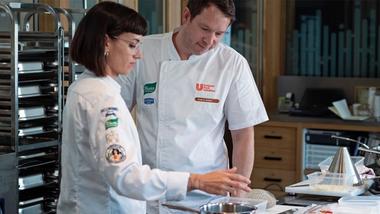When it comes to bouncing back better, Unilever Food Solutions’ two-year turnaround is a case study in crisis management, agility and teamwork.
With a business model anchored to supplying the food service sector, it was inevitable that UFS would be hit hard by the pandemic lockdowns. But nothing could have prepared the business for overnight losses of 70% with no sense of when things might pick up.
Today, UFS has surpassed pre-pandemic volume levels, with a huge reserve of customer loyalty and a B2B digital selling platform which has seen impressive growth both in terms of volume and reach.
- 100%2019 Value Index
- -70% 2020 Value Index vs 2019
- +112%2022 Value Index vs 2019
Lockdown Lessons
“Right from the first day of lockdown, the whole team was constantly thinking: ‘How can we protect the business and how can we protect P&L (Profit & Loss)?” remembers Star Chen, EVP, Unilever Food Solutions.
Whether it was helping businesses simplify their menus to meet the needs of delivery platforms or suggesting new products that would tolerate transit better, UFS made it clear from the very start of the lockdowns, that they were standing shoulder to shoulder with their customers through the pandemic.
“We started with little things like putting chefs in touch with delivery platforms, or helping them redistribute their waste through social enterprise organisations like Too Good to Go,” says Star. “But in the end, I think these are the things that will give us the biggest returns. We have huge customer loyalty.”
In lockdown, digital offered the only way to really fulfil the requirements of the chefs and restaurants we work with.
Star Chen, EVP, Unilever Food Solutions
Transforming the toolkit
However, for a business that was used to a face-to-face sales model, successfully continuing to serve customers during lockdown demanded a pivot to working online.
“We knew creating our digital capability platform was the first thing we had to do because fundamentally we are not just B2B (business-to-business), we are also P2P (people-to-people),” says Star.
“We work with chefs and restaurants that have specific requirements. In lockdown, digital offered the only way to really fulfil these requirements, as well as sharing data and advice with our consumers and our sales team.”
Although it was already in the pipeline, the digital transformation was fast-tracked and developed in record time following these four pillars:
Route to market: Operators were moved to eCommerce platforms with the creation of 27 online shops.
Digital sales: Sales reps were empowered with a made-to-measure digital app that increased productivity and reached more operators.
Data: Research and results were consolidated into a data hub, providing all sales reps with critical, at-a-glance customer view and intelligent data insights.
Independent marketing: 54 markets were empowered to send out their campaigns independently, resulting in 14 million emails being sent a year (compared to 4 million the year before), with no agency costs and with higher open and click-through rates.

Changing mindsets through training and support
However, getting the tech in place was only part of the puzzle. For a sales team that was used to a face-to-face sales model, switching to online meant a complete change of mindset.
“We knew we had to convince our sales team that the work they had previously done face to face could also be done digitally via remote support,” remembers Star.
“We created a remote customer visit process and invited chefs to join the call from their kitchens.”
And the demands on chefs did not end there.
The shift to a virtual world meant chefs were now asked to act as online influencers available 24/7 to support customers.
It is a role many took on enthusiastically and very successfully, thanks to UFS-created influencer guidelines and training.
Today, over 200 UFS chefs are still sharing information about products and recipes to more than 3.2 million social media followers, and thereby contributing to growth both in market reach and penetration.

Upskilling for sales growth
“But great ideas need landing gear as well as wings,” remarks Harpreet Sethi, UFS Global Head of Technology, explaining the critical role the online tuition modules provided by UFS played in empowering the team. “We created over 60 learning courses to upskill the local market experts and encourage them to use technology to drive business growth,” he says.
Today, more than 80% of the UFS sales team are now trained in digital sales. “This has led to significant productivity gains, with virtual meetings addressing the needs of twice as many operators with twice the strike rate than face to face,” says Harpreet. “All this has led to better GTM (go-to-market) productivity.”
And the numbers show it. In 2022, UFS’s value index reached 112% compared to its value in 2019. And conversion rates have also increased, in part, thanks to the introduction of the new UFS digital sales app which now covers 24 markets allowing 2000+ registered third-party reps to reach over 50,000 operators.
Leveraging digital data power
With results like these, it’s clear that the digital model is here to stay for UFS, especially as it also supports one of the key assets for the business: its proximity to user needs.
“Our business model means that we have always been very close to the users of our products, and to the market,” says Star. “Now we also benefit from the data collected from the digital platform, which combined with the data from our sales team, gives us incredible insight and puts us in a unique position to prepare for future menus in a credible way.
So what is on the menu for UFS?
“The top priority is to become the market leader in digital selling in the foodservice industry,” says Star with a smile, adding that they will approach this goal in the same way as they approach everything: by listening to their chefs.
